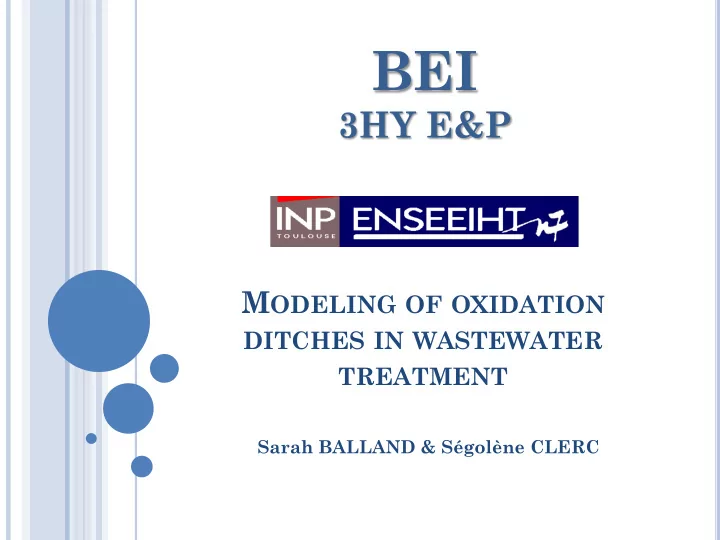

BEI 3HY E&P M ODELING OF OXIDATION DITCHES IN WASTEWATER TREATMENT Sarah BALLAND & Ségolène CLERC
P LAN Industrial context Presentation Objectives Equations Modeling of liquid flow only Modeling of spiral flow in cross section Modeling of the oxygen transfer Results Conclusion Opening 2
I NDUSTRIAL CONTEXT (1/2) Project O2Star D. Legendre A. Cockx 3
I NDUSTRIAL CONTEXT (2/2) Project O2Star Development of software for the conception, sizing and optimization of aeration system in wastewater treatment plant For water treatment industries From experiments and numerical tools To predict precisely the oxygenation capacity of oxidation ditch 4
P RESENTATION (1/3) Wastewater Treatment Plant (WWTP) :biological reactor Aeration : creates a bacteria activity => consumption of oxygen Mixers : creates stir 5
P RESENTATION (2/3) Grid of diffusers Guidevaine Tank 6 Mixers
P RESENTATION (3/3) Calculating the oxygen transfer Creation of a simple tool Matlab program Adaptation for all the reactors Variation of several parameters Functional tool For industrials 7
E QUATIONS (1/6) M ODELING OF LIQUID FLOW ONLY Mixers => flow inside the tank Losses : friction bend roughness Sum of Δ P = 0 inside the tank => U 8
E QUATIONS (2/6) M ODELING OF SPIRAL FLOW IN CROSS SECTION 9
E QUATIONS (3/6) M ODELING OF SPIRAL FLOW IN CROSS SECTION Geometry Mass conservation Momentum conservation 10
E QUATIONS (4/6) M ODELING OF SPIRAL FLOW IN CROSS SECTION Three zones : Entering : increasing of gas rate Permanent : maximum gas rate Exit : decreasing of gas rate 11
E QUATIONS (5/6) M ODELING OF THE OXYGEN TRANSFER Spring terms : Transfer of oxygen from air bubbles to water Well terms : Bacteria consumption of oxygen Disappearing of bubbles at the tank surface Free tank surface << Total bubbles surface Simulation in clean water => no bacteria 12 Neglecting of well terms
E QUATIONS (5/6) M ODELING OF OXYGEN TRANSFER x-discretization Kl : transfer coefficient a : interfacial area Umoy : average liquid velocity 13 Cs : gas concentration at saturation
R ESULTS (1/4) Gas and liquid velocities inside the rising part of the airlift 14
R ESULTS (2/4) Gas rate for several airlift sizes 15
R ESULTS (3/4) Oxygen concentration for several airlift sizes 16
R ESULTS (4/4) Gas rate for several bubble sizes 17
C ONCLUSION Project entirely built Hypothesis reflection Establishing of the equations Creation of Matlab program Results analysis Scientific and personal enrichment Using and improving of our two-phase flow skills Autonomy Contact with industrial world 18
O PENING To drag along bubbles inside the descendant part of the airlift To add a longitudinal airlift modeling To improve the precision of the calculations To consider the mixers influence upon the flow 19
Recommend
More recommend